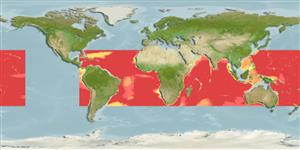Environment: milieu / climate zone / depth range / distribution range
Ecología
marino batipelágico; oceanodromo (Ref. 51243); rango de profundidad 256 - 500 m (Ref. 58302). Deep-water; 30°N - 37°S, 85°W - 150°W
Atlantic, Indian and Pacific: in tropical and subtropical waters; widespread between 30°N to 0° in the eastern Atlantic, unknown from the Gulf of Guinea/Benguela Current area. Does not occur in the Mediterranean Sea and in the eastern Pacific east of 150°W.
Tamaño / Peso / Age
Maturity: Lm ? range ? - ? cm
Max length : 10.2 cm SL macho / no sexado; (Ref. 10755)
Short description
Morfología | Morfometría
Espinas dorsales (total): 0; Radios blandos dorsales (total): 7-9; Espinas anales 0; Radios blandos anales: 18 - 21. Medial face of pectorals with dense black pigment (Ref. 6601).
Oceanic and mesopelagic (Ref. 6601, 58302). Most adults are taken in hauls to depths exceeding 500 m, none in hauls to depths less than 250 m. Larvae are taken year-round throughout its range, chiefly in hauls to depths less than 200 and apparently not in hauls restricted to the upper 100 m (Ref. 10755). Adults are presumed to prey on other midwater fishes. Synchronous hermaphrodites (Ref. 6691).
Life cycle and mating behavior
Madurez | Reproducción | Puesta | Huevos | Fecundidad | Larva
Johnson, R.K., 1990. Scopelarchidae. p. 393-397. In J. C. Quero, J. C. Hureau, C. Karrer, A. Post and L. Saldanha (eds.) Check-list of the fishes of the eastern tropical Atlantic (CLOFETA). JNICT, Lisbon; SEI, Paris; and UNESCO, Paris. Vol. 1. (Ref. 10755)
IUCN Red List Status (Ref. 130435)
Threat to humans
Harmless
Human uses
Pesquerías: sin interés
Más información
Nombres comunesSinónimosMetabolismoDespredadoresEcotoxicologíaReproducciónMadurezPuestaAgregación para la puestaFecundidadHuevosEgg development
Age/SizeCrecimientoLength-weightLength-lengthLength-frequenciesMorfometríaMorfologíaLarvaDinámica larvariaReclutamientoAbundanciaBRUVS
ReferenciasAcuiculturaPerfil de acuiculturaRazasGenéticaElectrophoresesheritabilidadEnfermedadesProcesamientoNutrientsMass conversion
ColaboradoresImágenesStamps, Coins Misc.SonidosCiguateraVelocidadTipo de nataciónSuperficie branquialOtolitosCerebrosVisión
Herramientas
Special reports
Download XML
Fuentes de Internet
Estimates based on models
Preferred temperature (Ref.
123201): 8.7 - 9.4, mean 9 °C (based on 12 cells).
Phylogenetic diversity index (Ref.
82804): PD
50 = 0.5625 [Uniqueness, from 0.5 = low to 2.0 = high].
Bayesian length-weight: a=0.01122 (0.00514 - 0.02450), b=3.04 (2.87 - 3.21), in cm total length, based on all LWR estimates for this body shape (Ref.
93245).
Nivel trófico (Ref.
69278): 4.2 ±0.73 se; based on food items.
Fishing Vulnerability (Ref.
59153): Low vulnerability (10 of 100).
